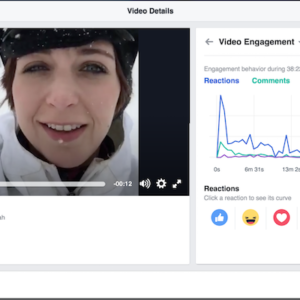Are you using social media listening for the online conversations about your brand?
Like most brands, you are already tracking the basics—your name, company name, competitors, and the occasional brand hashtag.
Well, you are certainly on the right path. But, what if you could go beyond the basics, do things differently, dig a little deeper?
In this article, you will learn about little-known tactics to improve your social media listening strategy.
Choosing Keywords When Social Media Listening
 When it comes to social media listening, most of us resort to using the usual keywords. This may include your own hashtag, product, or brand name. Of course, these are low hanging fruit and they might be useful starters depending on your social media monitoring goals.
When it comes to social media listening, most of us resort to using the usual keywords. This may include your own hashtag, product, or brand name. Of course, these are low hanging fruit and they might be useful starters depending on your social media monitoring goals.
However, sometimes your brand name, company name or product may not be mentioned overtly in comments or complaints. In such cases, you might miss the opportunity to engage customers or leads. This makes it important to use keywords innovatively to get the most out of your social media listening strategy.
Here are a few tips for optimising your social monitoring keywords:
- Use your brand keywords alongside your competitor’s brand keywords to monitor conversations about your brand and the other brands or products. The results will show you how consumers are interacting with your product versus other alternative products. You can use these results to improve your offering, position yourself better, or address customers’ pain points.
- Use long tail keywords carefully. Long-tail keywords get a lot of praise and for good reason. They embody the natural language that consumers use during those crucial micro-moments when they are searching for answers to specific questions.
- Using long-tail keywords to listen to social conversations seems like a no brainer. However, you can easily exclude some key results if you do not select the right keywords and monitor these phrases carefully. You need to monitor several variations of the same long-form keywords to retrieve meaningful results.
Identify The Right Influencers with Social Media Listening
Influencers have become an inevitable part of our day-to-day social media interactions. If used strategically, they can be quite beneficial to your business.
 Are you looking for the right influencer to collaborate with? Do you want to reach their followers who could be potential buyers? Knowing where to find the right person can be quite overwhelming.
Are you looking for the right influencer to collaborate with? Do you want to reach their followers who could be potential buyers? Knowing where to find the right person can be quite overwhelming.
Fortunately, with the right social listening strategy, you can identify suitable people to endorse your brand to the right audience.
Some of the best social listening tools combine analytics and content monitoring features. This allow you to monitor content created around a certain topic and the people who are sharing this content. Besides monitoring content sharing trends, you can also identify influencers based on specific keywords and hashtags.
Once you recognise key figures that are interacting positively with your content, brand, or product, you can reach out to them. Now is the time to discuss potential collaborative projects that can amplify exposure for your brand.
Social Media Listening to Identify Selling Opportunities
Most consumers use platforms such as message boards, social media, and review sites to research before buying a product. This is a great opportunity for identifying potential buyers. This is also known as social selling.
Through social media listening, you can position yourself to meet buyers’ needs.
You can answer their questions on time, alleviate concerns, and promote the features of your product or service.
Why should you use social selling?
Over the last couple of years, consumers have become more and more averse to all sorts of online advertisements. This includes native social media ads and banner ads.
 Social selling is a better alternative to online ads. Unlike these ads, social selling is less about overtly promoting your brand. It’s more about offering solutions just at the point when the customer needs assistance the most.
Social selling is a better alternative to online ads. Unlike these ads, social selling is less about overtly promoting your brand. It’s more about offering solutions just at the point when the customer needs assistance the most.
Social media listening lets you identify conversations about your product or products similar to yours. You can then be the first one to recommend a timely solution.
To generate helpful results, you need to use the common keywords in your industry. Also, use specific keywords that customers typically use to ask for product recommendations from peers across different online platforms.
While bottom-of-the funnel customers are important and only require a slight nudge to make that precious purchase decision, you should also be listening to top-of-the-funnel consumers.
Top of the funnel buyers may seem unimportant when it comes to social listening and social selling. They are new to the social conversations about your product, and are not ready to buy.
However, they are usually hanging out on social platforms looking for information about particular brands or products. Use your social media listening tools to identify the concerns of these buyers. You can then point them to relevant content or tools that address their pain points so they become ready for purchase.
Track The Effectiveness Of Your Marketing Efforts
A major challenge that marketers face is accurately tracking the effectiveness of each marketing strategy used. Whilst some analytic tools now make this process easier, social listening is effective when it comes to tracking your marketing efforts.
Whether you are looking to monitor conversations around your YouTube videos or a long-form white paper, tracking your brand name using the right social media listening tools can provide helpful insights.
When tracking the effectiveness of your marketing strategies, a good social monitoring tool should generate key metrics. This includes positive and negative brand mentions and engagement metrics. For example, shares, comments, favourites, likes, and retweets, and reach metrics and the number of views, shares, and impressions.
In turn, these metrics can help you measure brand awareness and perception. This is based on the feedback you receive from users and gives you the chance to improve your marketing strategies for better ROI.
Go Beyond Basic Mention Notifications
 Most social media listening tools allow you to monitor mentions in the form of bad or good product reviews, compliments, likes, and favourites. However, there is a way to go beyond these basic notifications. You can then get more in-depth results to refine your product or service and stay ahead of the competition.
Most social media listening tools allow you to monitor mentions in the form of bad or good product reviews, compliments, likes, and favourites. However, there is a way to go beyond these basic notifications. You can then get more in-depth results to refine your product or service and stay ahead of the competition.
Here are a few tips:
Use social media listening to find additional uses of your product or service. Whilst you should definitely track product mentions, consider monitoring the different ways customers are using your product other than its intended use. Then include this new information in your outbound content such as blog or social media posts.
Stay ahead of the game by monitoring industry trends. One of the best ways to remain competitive is to anticipate trends and formulate cutting-edge products and features. Use social media listening tools to keep track of the new trends people are looking forward to and become an industry early adopter.
Keep track of similar brands. Do you want to improve your product and meet the needs of your customers? Don’t just monitor your own product or brand. Keep an eye on other brands that are doing particularly well. Find out why consumers like this product. Use this information to adapt your product or service offering and position yourself as a better alternative.
Track and Analyse Your Brand Assets
Whilst most of us track brand names, products, and competitors, we often forget to monitor an important brand asset.
That is images.
Today, there is no denying that social has become more about visuals and less about text. It’s not uncommon for consumers to post images or products containing a brand logo without mentioning the specific brand in the caption.
This makes it necessary to ‘listen to images’ and monitor how consumers are interacting not just with your brand logo but also every image that is related to your brand. After all, you have probably spent a significant amount of money and time creating your brand visuals. So, it makes sense to see how your target audience is receiving this content.
Image listening takes you deeper into the social conversations taking place around your brand or related products and services. Therefore, in addition to monitoring your share of voice in the social space, you can track your brand’s share of eyeballs too.
Image Listening in user generated content campaigns
Another great benefit of image listening is tracking of user-generated visuals for specific campaigns. At any given time, it can be difficult to sift through images on social media to find those that are related to a specific UGC campaign. Using social media listening for image analysis, you can identify these images and better understand the impact of your campaign.
Even if you are not running a user generated content campaign, tracking social images lets you keep an eye on trends that are important to your customers. By monitoring your brand images, you can see the different ways people who post images of your product are using it. You’ll know why they are using it, and the context within which they are using it. With this kind of social intelligence, you can brainstorm and create content that resonates with your audience and fits with the current trends.
Lastly, image listening can help to identify influencers and track the reach and impact of your influencer marketing. You can easily understand how both major influencers and micro influencers use and share your product and how they interact with your brand.
Poach Your Competitors’ Dissatisfied Customers
 Monitoring your competitor is a basic social media listening tactic. But, if you want to take things to the next level, why not use competitor monitoring as a way to generate ready leads.
Monitoring your competitor is a basic social media listening tactic. But, if you want to take things to the next level, why not use competitor monitoring as a way to generate ready leads.
How does that work?
Not everyone who uses your competitor’s product or service is fully satisfied. There are always outliers who are looking for an additional feature or just a better alternative.
These customers are low hanging fruits that you can easily reach out to. Just understand their needs, and provide them with a better solution.
So, using your social media listening tools, track your competitor’s brand plus the negative keywords that customers may use to describe their product or service. Examples of common negative mentions include ‘bad’, ‘problem’ ‘terrible’ and so on. The specific keywords you use will, of course, depend on the niche, type of product, and relevant features.
Once you identify these negative mentions, reach out to the disgruntled customer and show them how your brand can help resolve the specific problems they are facing.
Adapt Your Brand Voice To That Of Your Customers
Are you speaking your customers’ language?
The one thing that successful brands have in common is the ability to understand nuances that are part of their customers’ identity. Indeed, consumers love brands that ‘get them’. Brands that understand their identity, and speak their language.
Speaking your customers’ language eliminates barriers and positions you as a relatable and accessible brand. Use social media listening to track the conversations your target audience is having so you can understand their lingo and tone. This way, you can create content that resonates with them, whether that is social media posts, web pages, blog posts, or videos.
Look specifically for things like slang words, memes and GIF trends that are particularly popular, hashtags, phrases, and keywords your target audience uses frequently. Use these in your content marketing strategy.
Social Media Listening
Social media has a significant influence on how we do business today. Any brand that wants to win will go deeper. They’ll listen to what consumers are saying, and use these insights to provide value and stay ahead of the game. If you are not listening to your audience, you are missing an opportunity to meet them at their point of need and offer the value they are looking for.






Leave a Reply